
The Teloschistaceae are a large family of mostly lichen-forming fungi belonging to the class Lecanoromycetes in the division Ascomycota. Collectively, the family has a cosmopolitan distribution, although members occur predominantly in subtropical and temperate regions. Although most members are lichens that either live on rock or on bark, about 40 species are lichenicolous – meaning they are non-lichenised fungi that live on other lichens. Many members of the Teloschistaceae are readily identifiable by their vibrant orange to yellow hue, a result of their frequent anthraquinone content. The presence of these anthraquinone pigments, which confer protection from ultraviolet light, enabled this group to expand from shaded forest habitats to harsher environmental conditions of sunny and arid ecosystems during the Late Cretaceous.
Jan Eric Ingvar Kärnefelt is a Swedish lichenologist.
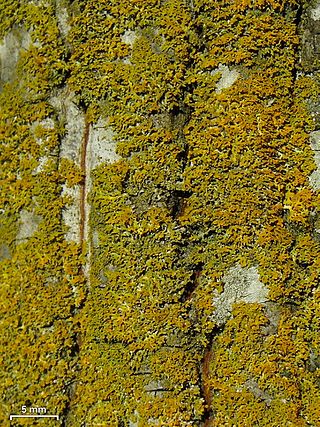
Gallowayella is a genus of lichen-forming fungi in the family Teloschistaceae. It has 15 species. The genus was circumscribed in 2012 by Sergey Kondratyuk, Natalya Fedorenko, Soili Stenroos, Ingvar Kärnefelt, Jack Elix, and Arne Thell, with Gallowayella coppinsii assigned as the type species. The generic name honours New Zealand lichenologist David John Galloway (1942–2014).
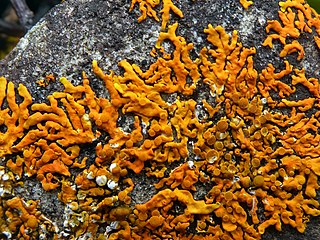
Dufourea is a genus of mostly foliose lichen species in the subfamily Xanthorioideae of the family Teloschistaceae. Species in the genus are mostly found in the Southern Hemisphere.
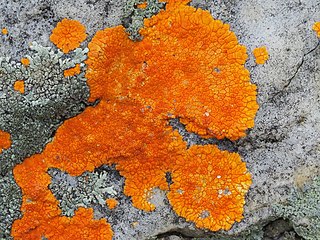
Brownliella is a genus of crustose lichens in the subfamily Teloschistoideae of the family Teloschistaceae. It has four species. The genus was circumscribed in 2013 by Sergey Kondratyuk, Ingvar Kärnefelt, John Elix, Arne Thell, and Jae-Seoun Hur, with the widely distributed lichen Brownliella aequata assigned as the type species. The genus contains species formerly referred to as the Caloplaca cinnabarina species group. The generic name honours Australian botanist Sue Brownlie.
Kaernefia is a genus of crustose lichens in the family Teloschistaceae. It has three species, found in Australia or South Africa.
Filsoniana is a genus of squamulose lichens in the family Teloschistaceae. It has six species. It was circumscribed in 2013 by Ingvar Kärnefelt, Arne Thell, Jae-Seoun Hur, Sergey Kondratyuk, and John Elix following a molecular phylogenetic analysis of the Teloschistaceae. The generic name honours Australian lichenologist Rex Filson, "in recognition of his contribution to lichenology, in particular to the lichen flora of Australia".
Gallowayella aphrodites is a species of corticolous (bark-dwelling), foliose (leafy) lichen in the family Teloschistaceae. It is found in the Mediterranean countries Greece, Cyprus, and Italy. Characteristics of the lichen include its small thallus, the disposition of the rhizines on the thallus undersurface, and the lack of vegetative propagules.
Neobrownliella is a genus of crustose lichens in the subfamily Teloschistoideae of the family Teloschistaceae. It has five species. The genus was circumscribed in 2015 by lichenologists Sergey Kondratyuk, Jack Elix, Ingvar Kärnefelt, and Arne Thell, with Neobrownliella brownlieae assigned as the type species. It is a segregate of the large genus Caloplaca. Characteristics of Neobrownliella include a thallus that is continuous or areolate, the presence of anthraquinones as lichen products, a cortical layer with a palisade paraplectenchyma, and the lack of a thick palisade cortical layer on the underside of the thalline exciple. Two species were included in the original circumscription of the genus; an additional three species were added in 2020.
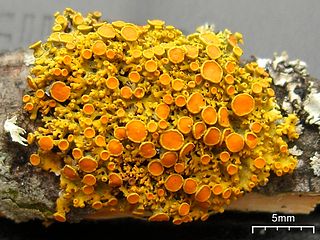
Gallowayella hasseana, the poplar sunburst lichen, is a species of corticolous (bark-dwelling), crustose lichen in the family Teloschistaceae. It occurs in North America.
Jackelixia whinrayi is a lichen in the family Teloschistaceae. It was first described in 2007 by Sergey Kondratyuk and Ingvar Kärnefelt as Xanthoria whinrayi, but was transferred to the genus Jackelixia in 2009 by Kondratyuk, Natalya M. Fedorenko, Soili Kristina Stenroos, Kärnefelt, and Arne Thell.
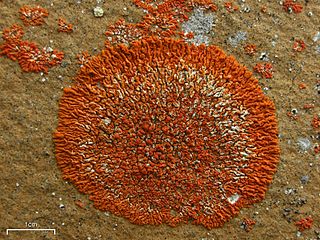
Rusavskia is a genus of lichen-forming fungi in the family Teloschistaceae. It has 12 species. It is a member of the subfamily Xanthorioideae. The thallus of Rusavskia is characterized by its foliose (leaf-like) structure with distinct and typically narrow lobes that curve outwards.

Martinjahnsia is a single-species fungal genus in the family Teloschistaceae. It contains the sole species Martinjahnsia resendei, a saxicolous (rock-dwelling) crustose lichen.
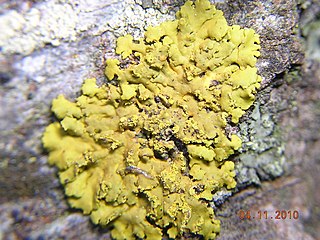
Gallowayella fulva is a species of foliose lichen in the family Teloschistaceae. It was first scientifically described in 1796 by German lichenologist Georg Franz Hoffmann, who classified it as a member of genus Lobaria. It has also been classified in the genera Oxneria, Xanthomendoza and Xanthoria in its taxonomic history. Sergey Kondratyuk and colleagues transferred the taxon to the genus Gallowayella in 2012, based on a molecular phylogenetics-based restructuring of some genera in the subfamily Xanthorioideae of family Teloschistaceae. In North America, one vernacular name for the species is the bare-bottomed sunburst lichen.
Sirenophila gintarasii is a species of lichen in the family Teloschistaceae. Found in Australia, it was formally described as a new species in 2009 by lichenologists Sergey Kondratyuk and Ingvar Kärnefelt, as a member of the genus Caloplaca. The type specimen was collected by the authors from the Camel Rock reserve. There it was found growing on coastal rock outcrops, along with the crustose species Sirenophila eos and Dufourea ligulata, some of which had been deformed by the lichenicolous fungus species Arthonia sytnikii and Pyrenidium actinellum. The species epithet honours Tasmanian lichen lichenologist Gintaras Kantvilas. Ulf Arup and colleagues transferred the taxon to the genus Sirenophila in 2013, following a molecular phylogenetics-based restructuring of the family Teloschistaceae. Sirenophila gintarasii occurs in New South Wales and Victoria.
Xanthoria yorkensis is a species of corticolous (bark-dwelling), crustose lichen in the family Teloschistaceae. Found in South Australia, it was formally described as a new species in 2009 by lichenologists Sergey Kondratyuk and Ingvar Kärnefelt. The type specimen, collected along the Maitland road in Yorke Peninsula, was found growing on Melaleuca trees in mallee scrub. The species epithet refers to its type locality, the only place the lichen is known to occur. Kondratyuk and colleagues proposed to transfer the taxon to the newly circumscribed Jackelixia in 2009, but this genus has not been widely accepted by other authorities.
Xanthoria kangarooensis is a species of corticolous (bark-dwelling), crustose lichen in the family Teloschistaceae. Found in Australia, it was formally described as a new species in 2009 by lichenologists Sergey Kondratyuk and Ingvar Kärnefelt. The type specimen was collected from East Kangaroo Island, where it was found growing on dead Lycium ferocissimum shrubs. Other associated lichens include species of Pyxine, Ramalina, and Rinodina. The species epithet kangarooensis refers to its type locality, the only place the lichen is known to occur. Kondratyuk and colleagues proposed to transfer the taxon to the newly circumscribed Jackelixia in 2009, but this genus has not been widely accepted by other authorities.
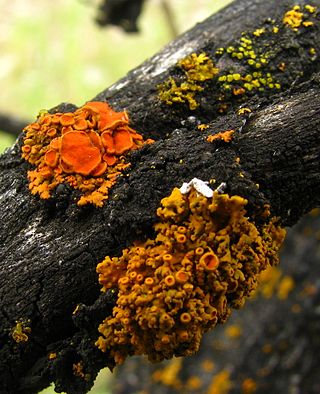
Gallowayella montana is a species of corticolous (bark-dwelling) lichen in the family Teloschistaceae. It occurs in North America.
Eilifdahlia is a genus of lichen-forming fungi in the family Teloschistaceae. It contains three species of corticolous (bark-dwelling), crustose lichens that occur in the Southern Hemisphere.
Franwilsia is a genus of lichen-forming fungi in the family Teloschistaceae. It has three species.








